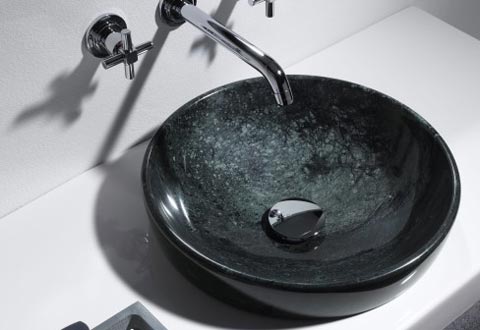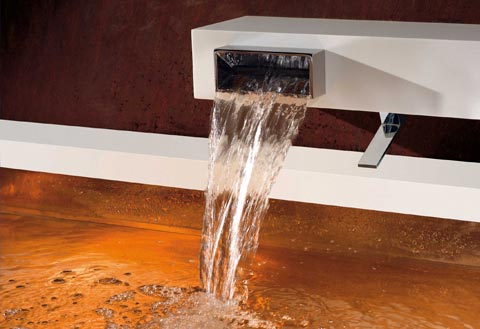In his book "Undesigning the Bath" published in 1996, author Leonard Koren stated that owing to their "reductive tendencies", industrial designers are not at all in a position to design good bathrooms: "The overriding character of most contemporary bath(room)s is that of a mix-and-match collage of off-the-shelf appliances - tubs, stalls, showerheads, soap trays, faucets, and so on - combined with waterproof surfacing materials." However, alarmed by the virtualization of our world and the mass mortality of things, triggered by the digital revolution, in the last ten or 20 years designers, manufacturers and clients have rediscovered the values of real objects, the tradition of handicrafts and materials and their relationship to the human body. During their search for authenticity, their creative focus has shifted to rooms that had become the apartment's poor relations thanks to the Modern Age's rationalization and efficiency-increasing measures; firstly the kitchen and then the bathroom. Thus many creative approaches are characterized by a return to the traditional, the familiar and the proven, in which not only individual product forms, but increasingly also the actions are taking center stage that people have been performing for centuries in the same or a similar way: in the kitchen the many different ways of preparing food, in the bathroom the cleansing and relaxation rituals. Design has rediscovered the qualities of the hamam, banja and onsen and thus also the central role of water in the bathroom as a place of purification and regeneration.
What sounds so banal and obvious is nothing less than a radical reversal in the understanding of that which a bathroom should provide. For centuries it was one of the greatest logistical challenges to get water into the home, which was designed to protect its inhabitants precisely from water. It was not until the late 19th century that people had running water in their homes and from then on it was considered an expression of human dominance over nature to direct it into strictly ordered channels, tell it where it is allowed to stay and prevent it spreading further with silicone, rubber lips and Aqua-Stops. The bathroom became a functional room, thus for decades "design for the bathroom" was almost exclusively the design of fittings, partitions, tiles and ceramics. However, even with his first bathroom range for Axor/Hansgrohe and Duravit of 1994, Philippe Starck not only succeeded in claiming for himself at lightning speed the current trend towards simplicity, he also created a reference to water in his designs which was communicated in advertisements congenially with images of archetypes: A cast iron well pump provided the template for the washstand fittings, a tin washbowl for the shape of the faucet, a zinc water bucket for the toilet - sanitary ceramics and fittings were suddenly historically charged objects where water was once again the most important thing. Likewise, the Vals Thermal Baths in Switzerland that Peter Zumthor built in 1996 no longer simply offered water sealed pools, but made it the protagonist in the interplay with the quartzite, with light and sound.
Thus in recent years, manufacturers of bathroom products have discovered the theme of the experience of water with all the senses: Fittings which produce little waterfalls and spray mist into the air call to mind rain or a bubbling spring. Even the Kneipp hoses, which always looked a bit improvised in the sauna, now radiate down-to-earth honesty and, as the "WaterTube", have been redesigned for the design-oriented bathroom. Contemporary bathroom ceramics symbolize expanses of water, indeed, entire pools and river courses, and are thus intended to convey authenticity, an appreciation of resources and a sense of nature. Together with the wide gushing fittings, the gently dripping rain showers and the washbowl-shaped faucets, materials have returned to the contemporary bathroom that people had long considered un-modern, unpractical, easily watermarked and not waterproof, such as wood, metals, unsealed stone or marble, as well as materials and combinations that did not stand at all for the Modern Age, functionality or hygiene, like bronze, copper and gold. Designers have rediscovered warm materials like brass and tin for all areas of the apartment which only a short time ago people had gingerly removed from every design-oriented home with their fingertips. Tom Dixon celebrates the beauty of copper with whole clusters of ball lamps made from this material. Alfredo Häberli uses the traditional kitchen material copper for his concept kitchen for Schiffini. e15 shows off copper or brass tray tables alongside its solid wood furniture. FSB juxtaposes the high-tech appearance of stainless steel handles with bronze handles, which patinate and tell of their past. There is the Eames coffee table with a gold leaf coating and Arne Jacobsen's "Egg" chair with a bronze base in a 50th anniversary limited edition. We have rediscovered the Austrian Carl Auböck's brass works and the beauty of Poul Henningsen's Artichoke luminaire in copper.
Copper bathtubs are also finding their way back into bathrooms, even being attributed with special therapeutic benefits. Golden taps, which for a long time could only be found in our imagination or Dubai, are now once again accepted designer accessories for the contemporary bathroom. Wooden elements even in faucets contrast with the insensitivity of surface materials which was required for decades. Unsealed travertine blocks, a rubble stone wall or shale cladding bring natural materials into the bathroom, on which water does not immediately roll down after a shower, but sometimes is still visible after several hours - and for which you don't need a squeegee. Evidence of use is no longer seen negatively as something to be removed, but is allowed to develop its own aesthetics. Indeed, even limescale deposits from a dripping tap can, if you just give them a little time as in some bathrooms in Istanbul or Budapest, grow into appealing stalactites.
A "bathroom with patina" - only recently if that had appeared in a property ad it would have been an obvious euphemism for mold in the cracks, broken tiles, limescale-encrusted fittings and dull enamel. Now it stands for a long-used ritual place, which as yet no other has staged and translated to products as perfectly as Mike Meiré and Sieger Design with the "Elemental Spa" by Dornbracht, presented in 2007. The fittings, designed in the form of bodies of water, stand for various cleansing and relaxation rituals; an area to wash your feet even makes reference to religious rites. Water is the focal point of the bathroom, in the course of time it deliberately leaves behind traces on the archaic-looking, oxidized Corten steel, on copper or olive wood, which tell stories about use and the past.
We can see this rediscovery of the cleansing ritual, the new appreciation of water, enthusiasm for patina and addressing of all the senses in the bathroom simply as the renunciation of the wellness trend, that exaggerated cult of regeneration and well-being, lulling esoteric rubbish which is highly lucrative. However, we can also make out in it an exploration of bathroom culture, archetypes and rituals, where designers are no longer satisfied with the selection of standard products and waterproof surfaces. The bathroom is one of the areas in which companies start out and realize in the form of products that which many consider design's primary task in the future, namely, the design of content and values, of culture and meaningful rituals, the consideration of connected actions and applications. The realization that even so-called "design products" cannot escape the millennia-old culture of things and actions if they want to be significant for people is reflected in the search for authenticity, a return to rituals and the rediscovery of bathroom materials which are able to form patinas. They reflect the experience that sooner or later, water will carve its course anyway. And the view that it is better to learn to appreciate the aesthetic value of patinas than to constantly buy anti-limescale agents.
 Starck 1 by Philippe Starck for Axor/Hansgrohe and Duravit
Starck 1 by Philippe Starck for Axor/Hansgrohe and Duravit
 Starck 1 by Philippe Starck for Axor/Hansgrohe and Duravit
Starck 1 by Philippe Starck for Axor/Hansgrohe and Duravit
 Starck 1 by Philippe Starck for Axor/Hansgrohe and Duravit
Starck 1 by Philippe Starck for Axor/Hansgrohe and Duravit
 Starck 1 by Philippe Starck for Axor/Hansgrohe and Duravit
Starck 1 by Philippe Starck for Axor/Hansgrohe and Duravit
 Axor Starck by Philippe Starck for Axor/Hansgrohe
Axor Starck by Philippe Starck for Axor/Hansgrohe
 Water Jewels by Matteo Thun for Vitra Bad
Water Jewels by Matteo Thun for Vitra Bad
 Water Jewels by Matteo Thun for Vitra Bad
Water Jewels by Matteo Thun for Vitra Bad
 Water Jewels by Matteo Thun for Vitra Bad
Water Jewels by Matteo Thun for Vitra Bad
 BA13 Meguro by Philipp Mainzer for e15
BA13 Meguro by Philipp Mainzer for e15
 CM05 Habibi by Philipp Mainzer for e15
CM05 Habibi by Philipp Mainzer for e15
 Copper Shade Pendant by Tom Dixon
Copper Shade Pendant by Tom Dixon
 Low Table Rod Base by Charles & Ray Eames for Vitra
Low Table Rod Base by Charles & Ray Eames for Vitra
 Low Table Rod Base by Charles & Ray Eames for Vitra
Low Table Rod Base by Charles & Ray Eames for Vitra

 Elemental Spa by Dornbracht
Elemental Spa by Dornbracht
 Elemental Spa by Dornbracht
Elemental Spa by Dornbracht
 Elemental Spa by Dornbracht
Elemental Spa by Dornbracht
 Elemental Spa by Dornbracht
Elemental Spa by Dornbracht
 Supernova by Sieger Design for Dornbracht
Supernova by Sieger Design for Dornbracht
 Supernova by Sieger Design for Dornbracht
Supernova by Sieger Design for Dornbracht
 WaterTube by Sieger Design for Dornbracht
WaterTube by Sieger Design for Dornbracht
 BA10 Aomori by Philipp Mainzer, Johanna Egenholf for e15
BA10 Aomori by Philipp Mainzer, Johanna Egenholf for e15
 BA07 Chiba by Philipp Mainzer for e15
BA07 Chiba by Philipp Mainzer for e15
 Copper Shade Pendant by Tom Dixon
Copper Shade Pendant by Tom Dixon
 FSB @ FSB, Franz Schneider Brakel GmbH + Co KG
FSB @ FSB, Franz Schneider Brakel GmbH + Co KG
 The egg by Arne Jacobsen for Fritz Hansen
The egg by Arne Jacobsen for Fritz Hansen
 PH Zapfen by Poul Henningsen for Louis Poulsen
PH Zapfen by Poul Henningsen for Louis Poulsen
